You never know what you’ll find behind closed doors in Los Angeles. On a steamy summer evening, I meandered through the confusing cultural landscape of the downtown Arts District, skirting the sidewalk “tent city” of Skid Row, sleek hipster bars and empty parking lots, to a desolate row of warehouses on Sixth Street. A lonely doorway was framed by a lush crimson mural of the Queen of Hearts whose embedded eyes seemed to follow me with curiosity. A tiny bronze plaque was engraved with the silhouette of a sphinx.
I pressed the door buzzer and a solemn, bespectacled young woman carrying a clipboard appeared. When my eyes adjusted to the sepulchral darkness inside, I found myself standing in a cocoon of velvety drapes and glittering chandeliers evoking the Moulin Rouge. I popped into the bathroom. The disembodied voice of a computer that called herself TESSA, a chirpy, comic version of HAL in 2001: A Space Odyssey, said she would be our guide for the evening, adding that the futuristic wonders we were about to behold were all built from materials “that can be purchased from Home Depot.”
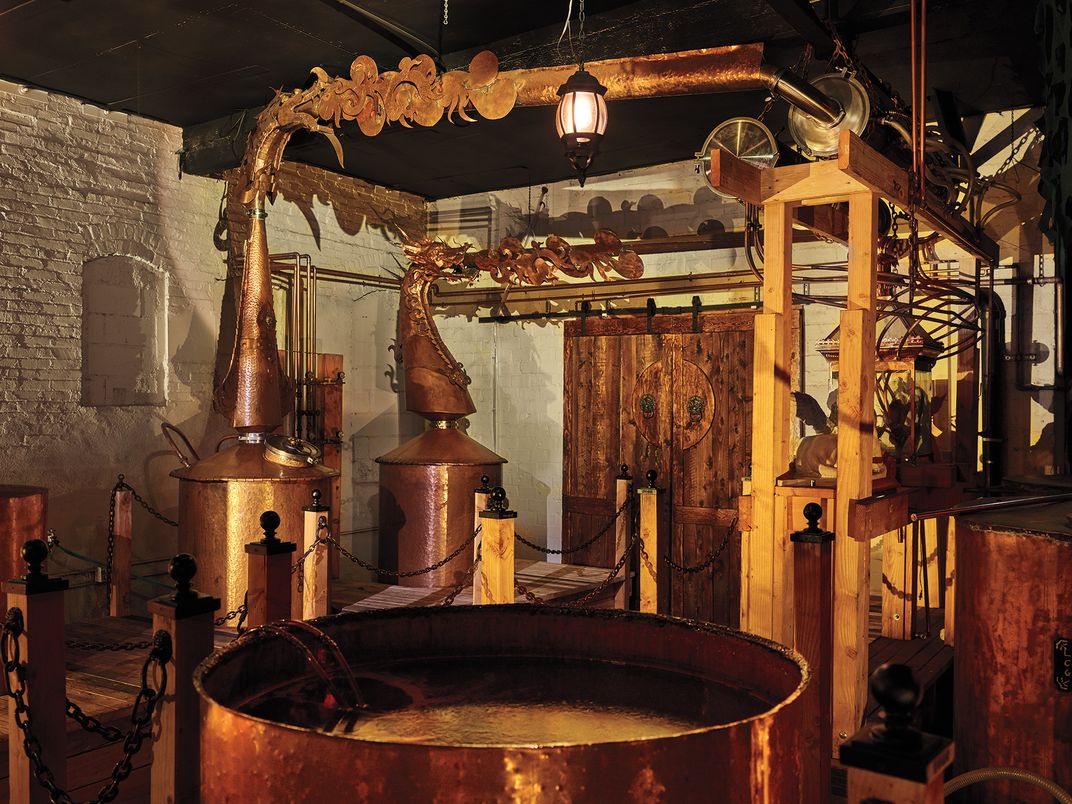
This is the world’s most surreal distillery tour, at Lost Spirits Distillery (motto: Science, Innovation, Art), a blend of heady chemistry and immersive theater that has become a cult hit among spirits geeks. It’s like a high-end Willy Wonka experience for adults, a Disneyland for drinkers; imagine the Pirates of the Caribbean ride taken over by eccentric MIT professors. But it also captures the loopy brilliance of a company that is tinkering with the laws of nature. Over the last decade, Lost Spirits has used molecular science to “hack” the chemical codes of fine aged spirits and recreate them in a patented reactor—cloning 20-year-old rums and malt whiskeys in just six days. And much to the horror of liquor purists, the self-taught, oddball group of distillers has recently won a slew of coveted spirits awards for its whiskeys and rums.
The next two hours passed in a dreamlike state, an effect possibly heightened by sampling a shelf-full of potent liquors. After TESSA gave a welcome address, ornamental portals opened to reveal a chamber where elegant goblets of British Royal Navy-style rum were perched for us on a Baroque astronomer’s globe. As we sunk into plush leather chairs, a (human) guide named Wayne explained that each sip of an aged spirit contains as many as 500 flavor compounds: “It’s the most complex thing you will ever taste,” he exulted. Thus primed, we savored the 61-proof rum transforming its effect every time it rolled along the tongue. Suddenly, on a word to TESSA, the visit kicked into operatic high gear with bursts of dramatic music, flashing lights and billowing smoke. Curtains opened to reveal a wooden barge, so we dutifully took a seat and floated in pitch darkness along a “river” through a noisy mock-jungle.
Our destination was a leafy wooden dock where vats of molasses were pungently fermenting, getting ready to be boiled in a still whose copper pipes snaked through what appeared to be the Ark of the Covenant. (Distilling 101: Alcohol boils at a lower temperature than water, so the still gathers the condensed vapors as raw spirits.) A door then opened on the high-tech “Dr. Frankenstein” segment of the tour, a lab where a shiny chemical reactor looking like it had been borrowed from NASA was rapid-aging the raw liquor. We were given a brisk lecture on organic chemistry, filled with arcane references to polymers, hemicellulose and short-chained fatty acids. (In brief, Lost Spirits technicians use high-intensity light to break components of wood apart and then use heat to put them back together again in a new order; when blended with alcohol molecules, they match the chemical fingerprint of matured spirits.)
From there, it was a leap from science back to Alice in Wonderland as we wandered through a garden of Amazonian plants being used to make exotic fruit brandies (“What happens if you give them the attention to detail and process that goes into a high-end Armagnac?” Wayne asked) and then sat on a floating circus carousel as artificial stars twinkled in the darkness. The last stop was a safari tent on “Whiskey Island” to sip malt while admiring a megalodon tooth, African wood carvings and a very plausible “dragon’s skull.”
Fantastical sets, the sense of irony, irreverent style—it’s all very L.A., of course. So too is the distillery’s obsession with controlling the passage of time. But while most Angelenos may dream of reversing the aging process, Lost Spirits is speeding it up. Why wait years for booze to mature when you can achieve the same thing virtually overnight? In a way, Lost Spirits turns back the clock and enables distillers to stock their cellars with aged liquors—retroactively.
No wonder that the distillery’s guiding light is H.G. Wells, he of the 1895 science fiction novella The Time Machine. (On the cover of the first edition is a sphinx—the company logo.) Wells’ lesser-known classic, The Island of Dr Moreau, about a scientist who upends the laws of nature by turning animals into humanlike creatures, is another key text. There’s a first edition in the distillery’s “Whiskey Island” room, and Lost Spirits blends are named after chapter titles, “Sayers of the Law” and “Crying of the Puma.”
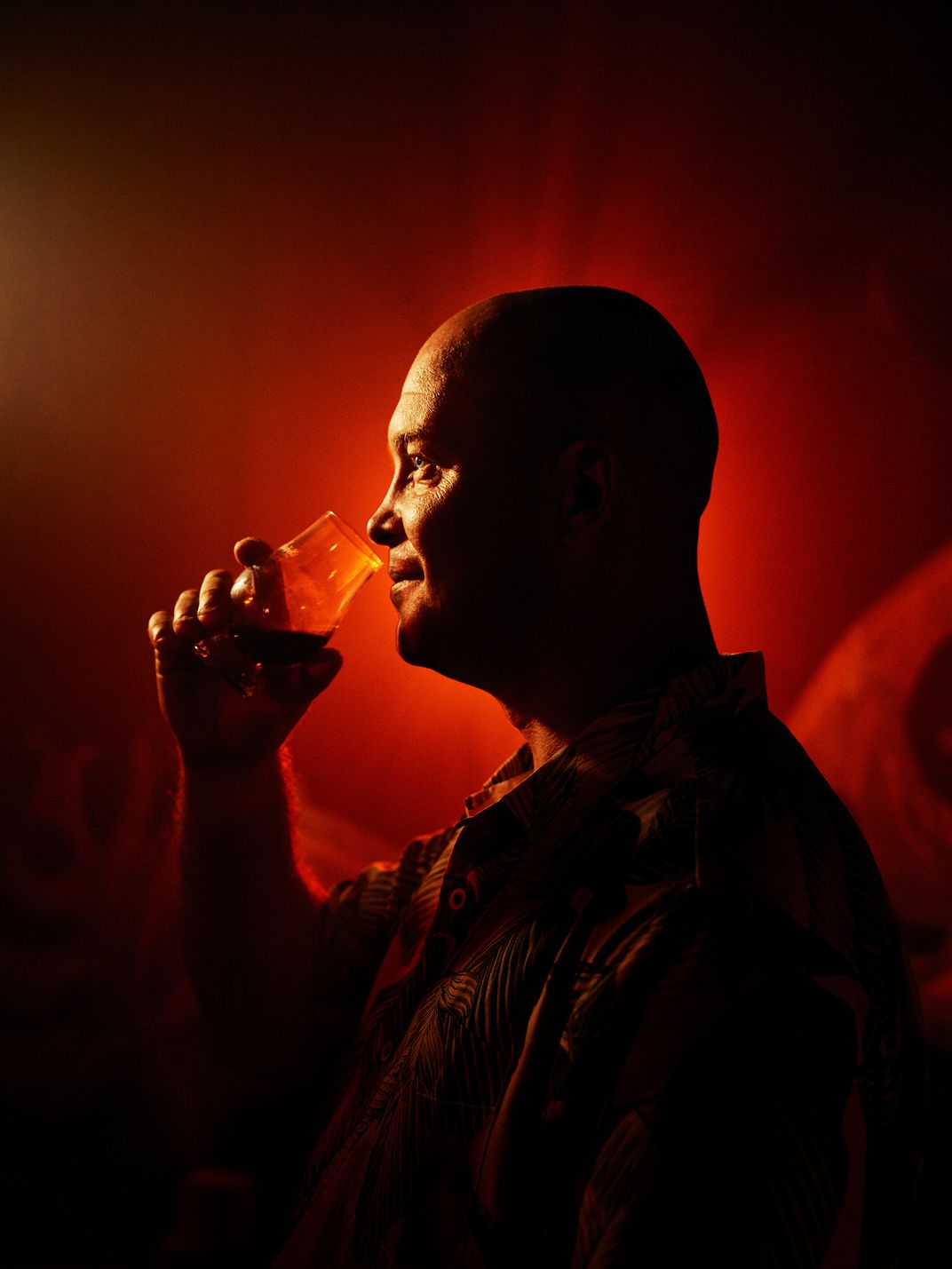
For history-lovers, the most thrilling possibilities lie in the firm’s forays into what it calls “booze archaeology,” which involves deciphering the exact makeup of such venerable tipples as Old Medford Rum, once America’s most beloved alcoholic beverage, purportedly sipped by Paul Revere on his epic ride in 1775. Social historians have long argued that we can learn a huge amount about a past culture from its attitude to the hard stuff. Now it’s becoming possible to taste the past.
* * *
Visiting the distillery at a quieter time, I found that even the behind-the-scenes workings are theatrical. The cavernous space is an anarchic cabinet of curiosities, filled with Victorian sideboards, tomes on forgotten Polynesian conquests and kitschy decorations salvaged from retro Los Angeles cocktail lounges. A wall is lined with valuable elixirs from E&A Scheer, an obscure but powerful rum trading company in Amsterdam. Gleaming Mac screens sit alongside containers full of fermenting star fruit.
“It’s like a tacky American version of the British Museum,” says Bryan Davis, who co-founded Lost Spirits a decade ago with his long-term partner Joanne Haruta, and now runs the company with a five-person team of “serious booze nerds.” He was attending to the lab’s most valuable piece of technology, the gas chromatograph mass spectrometer, or GC/MS. “It breaks down the chemicals in order of volatility, which is the way you taste things on the tongue,” Davis explained. The gray boxlike machine, the size of an average dishwasher, was vaguely menacing; it stabbed a vial with a needle, withdrew a drop of liquid and proceeded to analyze it, producing the results a few hours later in a multipage printout. The high-tech vibe was nicely offset by two statues of angels sucking on plastic tubes (a joking reference to “angel’s share,” the notion advanced by monks that the evaporation of barreled spirits must be the result of angels taking a sip).
“The booze industry has two distinct personalities,” Davis said as we wove past sheets of copper and jars of bacteria. “There’s all the big-name companies who fill the grocery shelves with consumer products. And then there are the small boutique producers, whose bottles people buy to savor and appreciate and discuss together for hours, like artworks.” With a shaved head and dressed in a Hawaiian shirt, Davis is a cross between a mad scientist and a medieval alchemist, although one who runs a 1950s tiki bar. Perhaps because he is self-taught, he has a talent for making organic chemistry comprehensible, and is given to half-jokey pronouncements. “It’s yeast’s world,” he says at one stage, stirring a pungent vat. “We just live in it.” Digressions touch on how the desire to brew beer spurred Neolithic agriculture, or the unlikely origins of the absinthe craze in the 19th century. (The liqueur took off when French soldiers in Algeria and Indochina discovered that it warded off malaria.) He is just as happy talking about chemical formulas as parsing the intricacies of the Harry Potter ride versus Transformers at Universal Studios Hollywood. “I have the same interests as a 13-year-old,” he says. On one visit to the distillery, we went to a restaurant in Little Tokyo, a conveyor-belt “sushi-train” where the plates can activate a televised battle between ninjas and monsters trying to destroy world cities. “Isn’t that the coolest thing ever?”
Even while sitting at Davis’ lab desk, trying to untangle the story of Lost Spirits took some doing. Like characters in a sitcom, team members interrupted every few minutes to offer a new snippet or show an artifact. One research partner, Wynn Sanders (nicknamed “Colonel Sanders” because he once worked for the U.S. military), excitedly brought over a rare wood used in Gilded Age barrels. A young scientist named Robyn, who worked in her gym clothes so she could exercise in a yard nearby, popped over to discuss a chemical printout. (“I did my PhD on the GC/MS and I love whiskey! So I combined my two passions.”) A devotee named Josh, who was not an employee but just liked hanging out at the lab, had procured dozens of tiny bottles of 1960s-era rum on eBay, which we all savored like fine cabernet. And there were constant calls from suppliers and regulators. “It’s like being stuck on a pirate ship,” he laughed. “Some days, I’m just a simple carpenter. Other days, cannonballs are being lobbed at you!”
* * *
The saga of Lost Spirits is an unlikely paean to the creativity in suburbia. One day, at 16, Davis decided to make booze. “I am a curious person. My cousins owned a winery so I knew how to make that. But how do you make spirits?” With a plastic bucket, a hollowed-out champagne cork and a metal coil, he built his first still based on a design he’d seen on “The Simpsons.” Adding yeast, sugar and molasses, he made a floral concoction that looked and tasted “like red Kool-Aid.” He was soon able to trade his booze for rides to Burning Man. Davis had found his calling.
/https://tf-cmsv2-smithsonianmag-media.s3.amazonaws.com/filer/f4/f2/f4f229b7-7f9a-4d50-962e-5241f27722eb/apr2019_c12_diptic_distillery.jpg)
The spontaneous, improvised nature of his research would remain a theme, even if Davis talks about his career shifts the way academics discuss Picasso’s Blue Period and Cubism Period. His “absinthe period” began shortly before he was a sculpture student at San Francisco Art Institute and learned that the long-banned “green fairy” beloved by the French Impressionist painters had been legalized in much of Europe after nearly a century. (“I thought: That’s really cool! I need this in my life.”) Davis and Haruta, who had met in college, moved to a village outside Barcelona, Spain, where they used 19th-century recipes found in old newspapers to “bring back from the grave” an absinthe made from lemon balm instead of hyssop flowers. “We made something pretty palatable,” he says. “This was not what van Gogh cut his ear off drinking!” (Absinthe’s popularity with artists comes from its key ingredient, wormwood, which gives a slightly different effect to alcohol, Davis says, making the nervous system fire faster. “It plays with your brain chemistry. You can drink but also play chess!”) It became such a hit in Paris that there were “green hours,” a forerunner of “happy hour.” But absinthe gained an unfair reputation for provoking fits of violence and was banned in the early 1900s, making it the first “controlled substance.” The U.S. ban of 1912 lasted until 2007.
Davis’ “bourbon period” began in 2009. With craft distilleries taking off from Brooklyn to San Francisco, he and Haruta decided to start Lost Spirits on land in central California near Salinas owned by her parents. The pair borrowed $80,000 and built a commercial distillery from scratch using copper sheet metal, wooden barrels on sale in Napa and a disassembled old boiler they found on Craigslist. (The standard cost is $600,000.) Poring over New York Times articles from the 1890s, they also decided to recreate a forgotten frontier contraption called “the log and copper still.” Early American settlers had limited access to copper, so they used the materials on hand: a tree trunk split in two, each half hollowed out like a canoe and bound together at the end to form one long log. The log would be filled with fermented rye until it swelled and became watertight, using metal only for the head and condenser. It would then be lit on fire, boiling the liquid inside to separate the alcohol. Davis’ modern remake distilled the first so-called “steam bourbon” anyone had tasted in a century. “There’s a myth that booze is better now, that people drank to just get drunk,” Davis says. “It’s totally the opposite. Thanks to the artisanal process, spirits were heavier and more flavorful.”
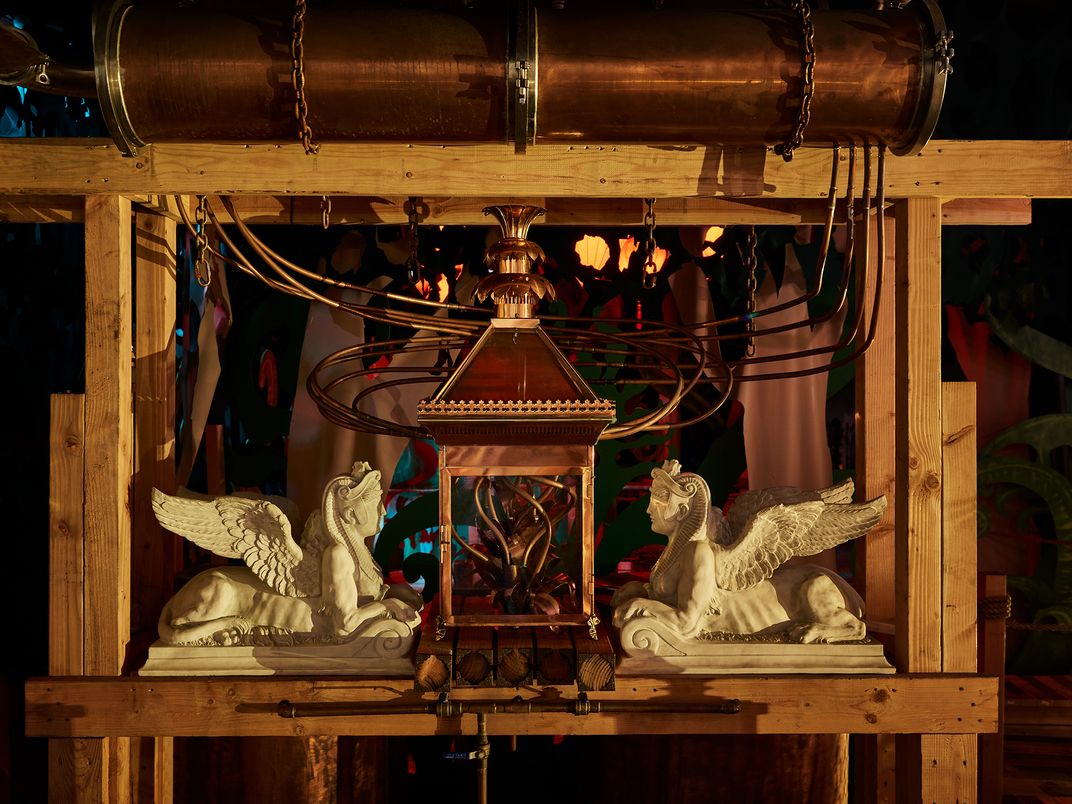
The “whiskey period” took Lost Spirits on a more avant-garde track. “We moved from ancient arts to ultra-contemporary,” he says. “We wanted to find flavors that nobody had ever tasted before.” Now using a peat-smoked still with a cupola-shaped chimney (a dotty Scottish tradition), Davis experimented with adding bacteria during fermentation—microbes cultivated on bananas, for example—to provide extra layers of flavor. He dabbled in yeast manipulation. (“Yeast is the fastest-evolving organism on the planet,” Davis enthuses. “Its cells reproduce every few hours. They have superpowers!”) He even fermented using Pacific Ocean seawater. (“Thanks to the seaweed, beach water is very alive. It’s full of coastal bacteria!”) The result had the aroma of the beach combined with a distinctive briny taste. (“It had a killer sense of place.”) Aficionados flocked to their quirky tasting room—a mobile home decorated like an estate in the English countryside.
* * *
At last, in 2010, Davis decided to unravel the science behind how spirits mature. “This is where things get complicated,” he warns—and he’s not exaggerating.
In short, the traditional method of aging since the Middle Ages—placing raw spirits in charred white oak barrels, then hiding them in a dark cellar for years—involves a series of complicated molecular reactions. First, polymers in the wood break down in a process called “extraction.” This produces a variety of aromas, appealing ones such as smoke, vanilla bean or pine menthol, and less appealing ones, he says, like “barf” (from a short-chained fatty acid called butyric acid). But as these compounds leach into the alcohol, a second reaction, “esterification,” occurs. Alcohol molecules bind to the polymer fragments and recombine to create 500-odd new flavor compounds. The “barf aroma” compound, for example, when tied to an ethanol molecule, smells like pineapple, then honeysuckle. After a couple of decades, when the taste and smell balance is most alluring—with lush honey notes or rich fruit balance—the distiller bottles it.
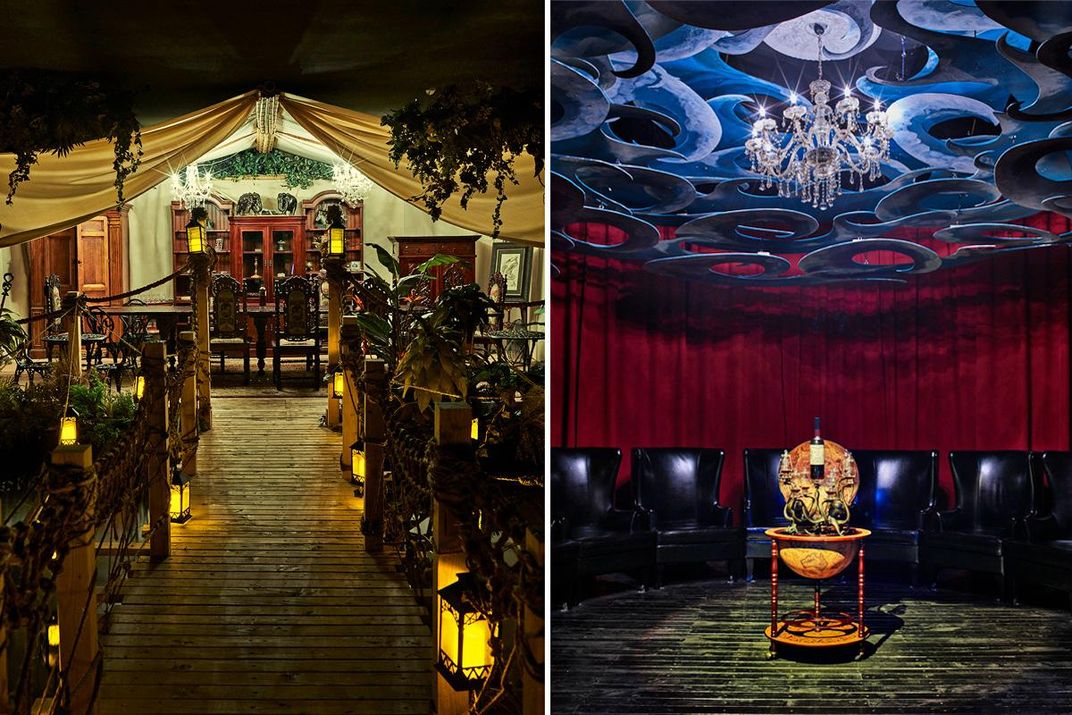
For centuries, boozehounds have dreamed of speeding up the process, which is agonizingly slow, expensive and wildly inefficient, since a large percentage of spirits are lost to evaporation. So Davis set out to reproduce it in laboratory conditions. He obtained a bottle of a famous 33-year-old rum from Guyana, the 1975 Port Mourant beloved by connoisseurs, and had it chemically analyzed. Armed with the molecular fingerprint, he entered his “rum period.”
The stumbling block, he found, was breaking the wood polymers apart, a reaction that seemed impossible to speed. The eureka moment came by accident one weekend, when he decided to paint his wooden house deck, which was fraying in the Californian sun. “I was thinking: ‘The sun is doing one hell of a job of breaking up the polymers on the deck.’ I got 100 yards away and thought: ‘Hey, wait a minute!’” He got every lamp in the house and blasted a piece of wood in a tube of raw spirits until blowing the electrical circuits. The result tasted like nail polish, but it had worked: The strong light had shorn aromatic compounds from the wood polymers.
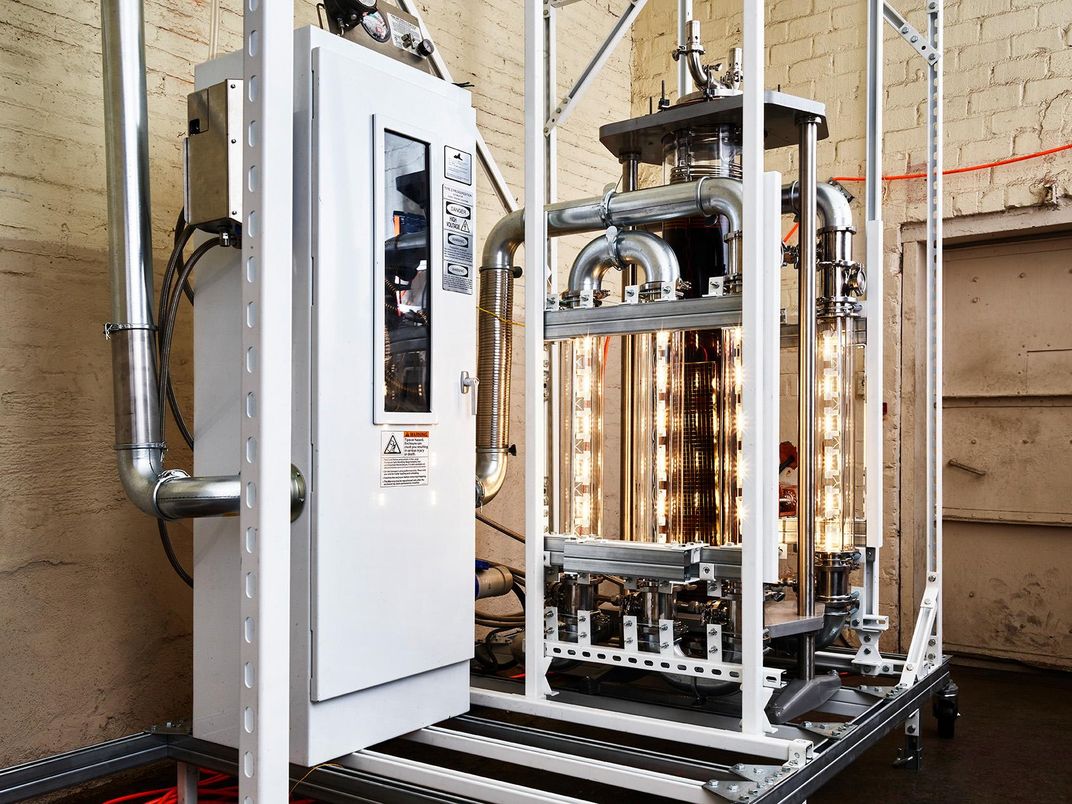
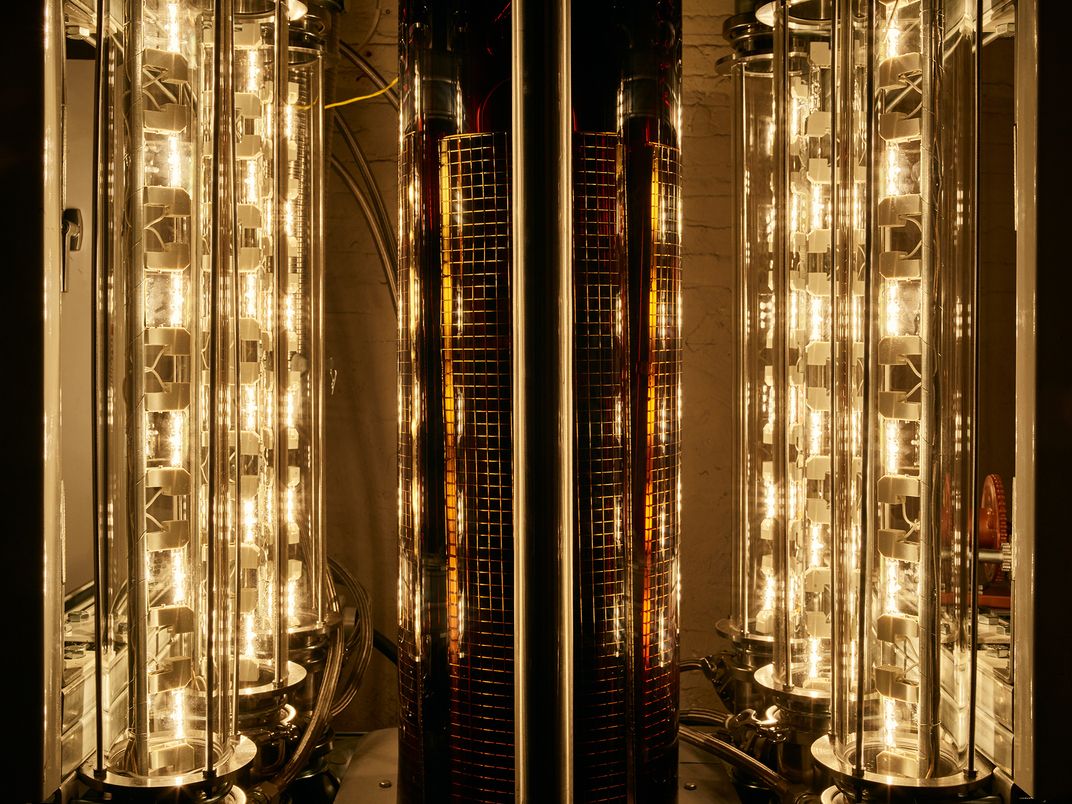
Davis then built his “rapid-aging spirits reactor”—which at different times was called Model 1 and THEA, after a Greek goddess related to the sun, although Davis prefers “time machine for booze”—to induce both extraction and esterification. This sleek array of tubes and metal containers is the centerpiece of the distillery tour. Inside a large glass cylinder, raw spirits and oak pieces are subjected to light three times as strong as the sun at the Equator. After the wood polymers break apart, the liquid goes through controlled heating to bind the compounds together, forming the complex long-chained esters we recognize from spirits matured in a barrel. The sweet spot is six days, Davis found, which matches the flavor of around 20 years. “And on the seventh day, we rested,” Davis deadpanned. “That’s my favorite line. I engineered the process for months to get it down to six days, just so I could make that joke.”
Lost Spirits’ first technologically aged product, Colonial Inspired Rum, came out in 2014. “We were terrified at how customers were going to respond,” he says. But the reviews were good, so in 2015, Davis published his findings in a white paper. After interest from biochemists and other investors, he essentially became a Silicon Valley tech company and secured patents and leased out manufactured reactors to international spirits companies.
Not everyone is enchanted with instant molecular “aging.” Edgar Harden, a London dealer of antique spirits, argues that only time can provide the subtlety and character of a truly great liquor. “I liken their process to artificially creating an antiqued finish on an old piece of furniture or a painting,” he said. “You might kind of get the antiqued look by using solvents and polishes and dirt, but nothing replaces real dust and grime building up on an organic surface over centuries; that’s patina.”
Others embrace it. The turning point was a 94 rating for Abomination peated malt by Jim Murray’s Whisky Bible 2018, placing Lost Spirits in the top 5 percent of 4,600 international whiskeys sampled. Many mixologists share the reaction of Sean Muldoon, the managing partner of the Dead Rabbit Grocery & Grog in New York, one of North America’s most awarded Irish taprooms, when given a blind tasting of the six-day-old whiskey and rum: “You’re kidding me. It’s bloody good.”
In 2016, Lost Spirits moved to Los Angeles and set up a new high-tech lab-distillery in the Arts District, along with a tasting room for bartenders, chefs and connoisseurs who lived to discuss the ins and outs of mold and peat burning while sitting in a faux jungle. It became so popular that Davis reinvented it in 2018 for the public by reservation. The blend of education and artistry has struck a chord. “I didn’t know what I had gotten myself into at first,” says Genevieve Liberté, a Los Angeles-based model and producer who was on the tour I joined. “I felt like I had stepped through the magic cupboard into Narnia. But somehow it managed to include a crash course in organic chemistry. I’ll never look at a cocktail the same way again.”
* * *
For die-hard nostalgics, it’s the reactor’s potential for cloning antique spirits that creates the most feverish dreams. Old Medford Rum, which was first produced in Medford, Massachusetts, around 1715, remained the most popular U.S. spirit throughout the 18th century, but when the family-run company closed its doors in 1905, the name was sold and the recipe was lost. Today only a few bottles exist, selling at auction for around $10,000 each.
Which is why, on my last visit to Lost Spirits, Davis and his crew gathered proudly around an eccentric inventor of medical supplies named Wayne Upton, who opened a small padded Pelican case and carefully produced two vials, one labeled “Medford c. 1858,” the other “Medford October 2017.” He opened the rare original 19th-century sample. “Have a smell. It was bottled when Abraham Lincoln was campaigning for senator!” We passed the vial around, savoring the surprisingly sweet, fruity aroma from a century and a half ago. “It tastes like cherry cough medicine cut with cologne,” Davis confided. “But in a good way! It’s different from anything else in the world.”
To recreate the elixir, Upton had obtained a sample from a sympathetic and very secretive collector. (The ginger-haired Upton moonlights as a top-shelf rum connoisseur, serving bottles from the back of his car in Los Angeles parking lots to fellow aficionados in his so-called “Trunk Club.”) At Lost Spirits, the team put drops in the spectrometer and analyzed its chemical fingerprint; the evidence suggested that the yeast strain found in Medford was unique, so they dispatched a member of the team to Massachusetts to collect samples in situ.
If you happened to be in Medford Square one hot night in July 2017, you might have witnessed a stocky, middle-aged researcher creeping around the moonlit Salem Street Burying Ground laying petri dishes by the gravestones. Each one contained Grade A molasses and distilled water, designed to capture wild yeast, which floats in ghostly traces in the air and, despite mutations over time, remains specific to its location. He continued to the Mystic River to lay other dishes at the spot where Caribbean molasses was once unloaded from boats, and he ventured beneath the stone Cradock Bridge, which Revere had crossed on his famous ride. (The researcher asked to remain anonymous, worried that his nocturnal mission had a certain grave-robbing air. “Laying petri dishes in a public cemetery,” Davis pondered. “Do you need a permit for that?” “A bottle of Scotch was involved too,” the researcher confessed.)
The next morning, some petri dishes had disappeared, others were spoiled by dog’s paw prints and apparent “canine saliva,” but nine had captured yeast strains that could be isolated. The researcher incubated them for three days in his hotel room with the thermostat set at a yeast-friendly 80 degrees. (“It was an uncomfortable weekend.”) Two strains from the cemetery turned out to be almost identical pairings with the 1860 version, perhaps because the verdant site has changed very little over the generations. Back in Los Angeles, the cultures were grown and distilled into the raw, white rum. “I’d never seen any yeast that potent,” marveled Davis. “It’s as fragrant as hell. It’s as flavorful as it gets, right at the beginning. I just like opening the jar of it and breathing it in.”
“Now try this,” Upton said, passing me the second vial from his case. “It’s the first real Medford rum made in over 105 years.”
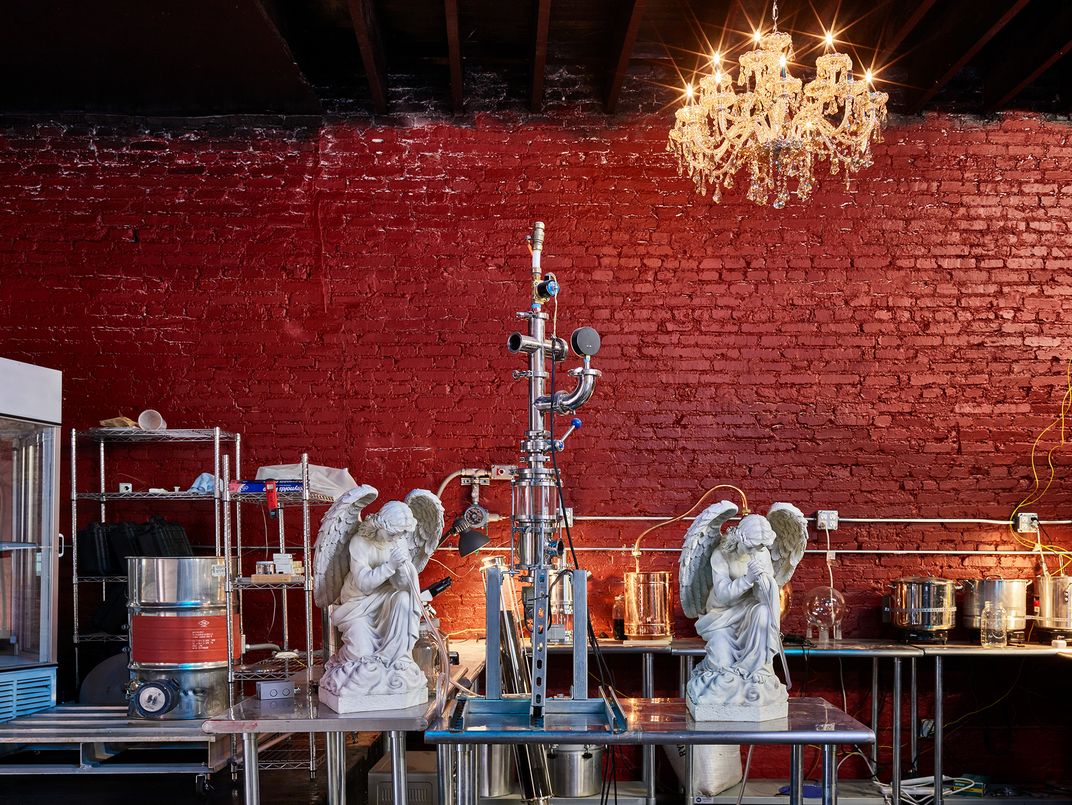
I reverently sipped the rum clone in its raw form; it had a searing potency, living up to its reputation as being strong enough “to make a rabbit bite a bulldog,” but it also had the unmistakable tang of the 1860 version. (“It’s like biting into a cherry,” Davis said.) The next step in the cloning process is to treat larger quantities of the raw rum with antique wood in the chemical reactor. This requires another mad quest: In the 19th century, rum barrels were made from American chestnut, a tree that once covered the entire Eastern Seaboard but was wiped out by a blight in the early 1900s. Only a handful of isolated, protected groves survive, making it one of the rarest plants in the world today. But two American chestnut trees had fallen in a storm in Washington State. Colonel Sanders was dispatched to buy the trunks and bring them back to Los Angeles.
I left the group chatting about other legendary tipples that might be resurrected. What about the fabled 19th-century “Bonaparte” rum, purportedly distilled on the plantation where Empress Josephine was raised on the island of Martinique, a flask of which Napoleon supposedly carried every time he went into battle. The true holy grail, Davis insisted, was an obscure Jamaican rum called J. Wray & Nephew 17. It has been a tiki bar legend ever since the 1940s, when a California bar owner named Victor J. Bergeron (a.k.a. Trader Vic) used it to create the mai tai cocktail. Today, there are believed to be only nine bottles left, and the last one went for $54,000 at auction—one of the most expensive bottles of spirits in the world.
But what price can you put on such a visceral connection to the past? Davis reminisced about once bidding over $18,000 on a J. Wray & Nephew 17 bottle of rum before being forced to drop out. “We had passed the point of sanity,” he admitted, with a faraway look in his eye. “But you’re not just buying a bottle of rum. You’re buying the dagger that stabbed Rasputin!”
If Lost Spirits continues to thrive, one day in the near future everyone will have access to such rare treasures.
Planning Your Next Trip?
Explore great travel deals
Smithsonian magazine participates in affiliate link advertising programs. If you purchase an item through these links, we receive a commission.
:focal(1192x787:1193x788)/https://tf-cmsv2-smithsonianmag-media.s3.amazonaws.com/filer/4f/98/4f981511-50f5-476e-956b-d1986812616b/apr2019_c11_diptic_distillery.jpg)
/https://tf-cmsv2-smithsonianmag-media.s3.amazonaws.com/accounts/headshot/tony.png)